As an Amazon Associate I earn from qualifying purchases.
You can read my full disclosure statement here.
Today we will be answering the question, does zucchini need a trellis to grow? We are going to discuss this and also share many tips on how to grow zucchini and summer squash..
Zucchini plants are a common plant in the home garden and a favorite of vegetable gardeners. They produce a lot of food, and grow quickly with little effort.
They do take up a lot of space, and are prone to fungal diseases and powdery mildew. Is growing them vertically a way to help prevent this?
Tips for Growing Zucchini and Summer Squash
Zucchini and summer squash are one of the easiest vegetables you can grow. You may have heard all the jokes about neighbors sneaking zucchini's onto your porch, or people desperate to give them away, and this is why.
They grow easily, and they get huge in the blink of an eye! So they are great for beginners to grow, and a single plant or two plants is usually enough for an average size family.
Zucchini are not easily stored well as they cannot be canned except for zucchini relish or with tomatoes. So freezing them or dehydrating them is your best option if you do become over run with them.
Zucchini is just one variety in the summer squash family of plants. All summer squash varieties are a warm-season plant.
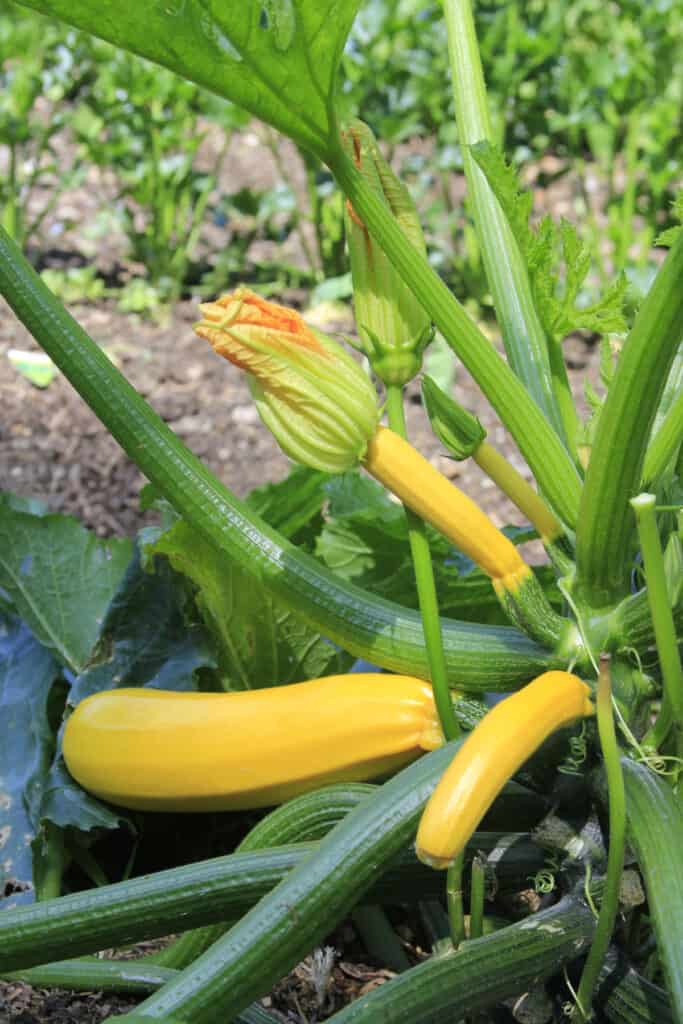
These are golden zucchini, a bush variety of zucchini.
Sauteed Zucchini and Garden Vegetables Side Dish Recipe
How to Make Zucchini Fries in an Air Fryer
Seed Starting Schedule for Garden Zone 8b
Seed Starting 101: Essential Seed Starting EquipmentOur favorite Homesteading and Gardening tools in our Amazon Shop!
Our Garden Harvest Tally Spreadsheet is now available!
Planting Zucchini Seeds
It is easy to start zucchini seeds or other summer squash seeds, by directly sowing them into your garden. Wait until all danger of frost has passed, and that night time temperatures stay above 50 degrees before planting.
You can plant them in rows or in hills. If planting in hills, sow 4-5 seeds per hill, then thin down to 3 healthy seedlings.
If planting in rows, plant 2-3 seeds and thin to 1 or 2 plants at most. Rows should be 4-6' apart, and plants should be 30" apart.
Planting Zucchini Seedlings
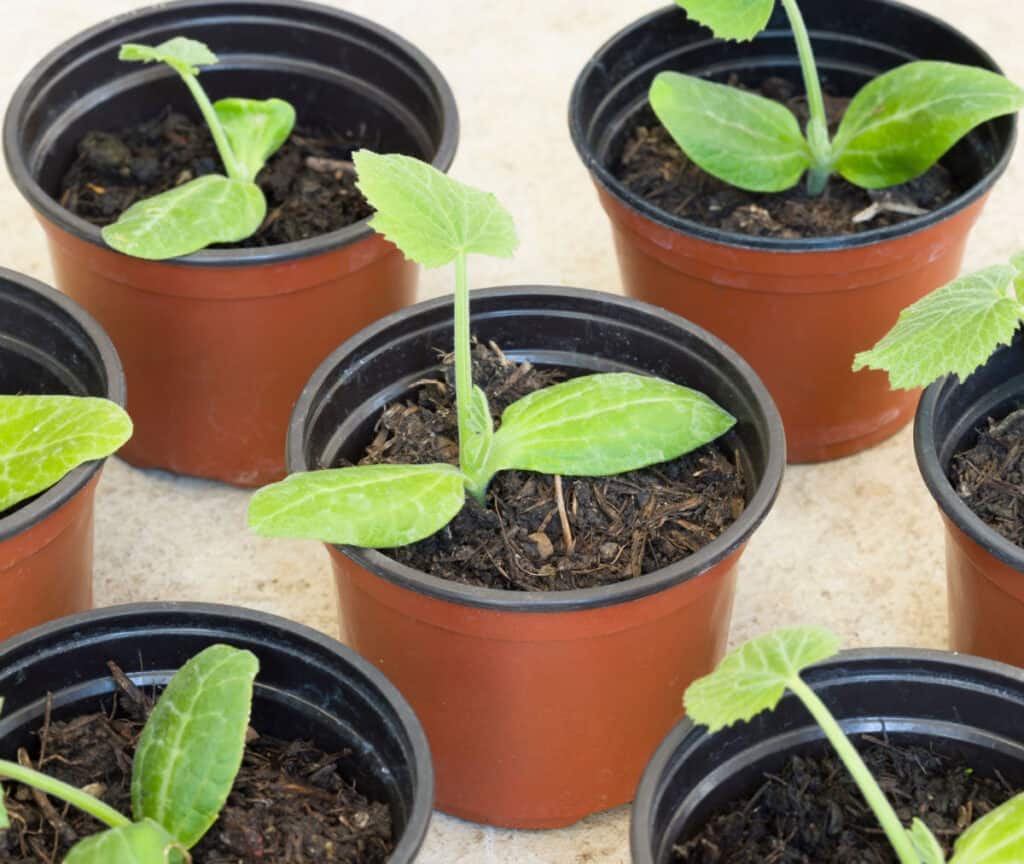
All squash family seedlings look very similar and they are hard to tell apart at this age, so be sure to label them!
You can also buy young plants at garden centers or local nurseries, and just plant them directly in the ground. Look for healthy plants and choose smaller ones rather than larger ones.
Or you can start zucchini seedlings indoors and plant them out when the temperatures warm up. Transplanting a seedling always causes the plant to go into shock, and I have found that directly seeding the plants, they catch up to larger seedlings in no time.
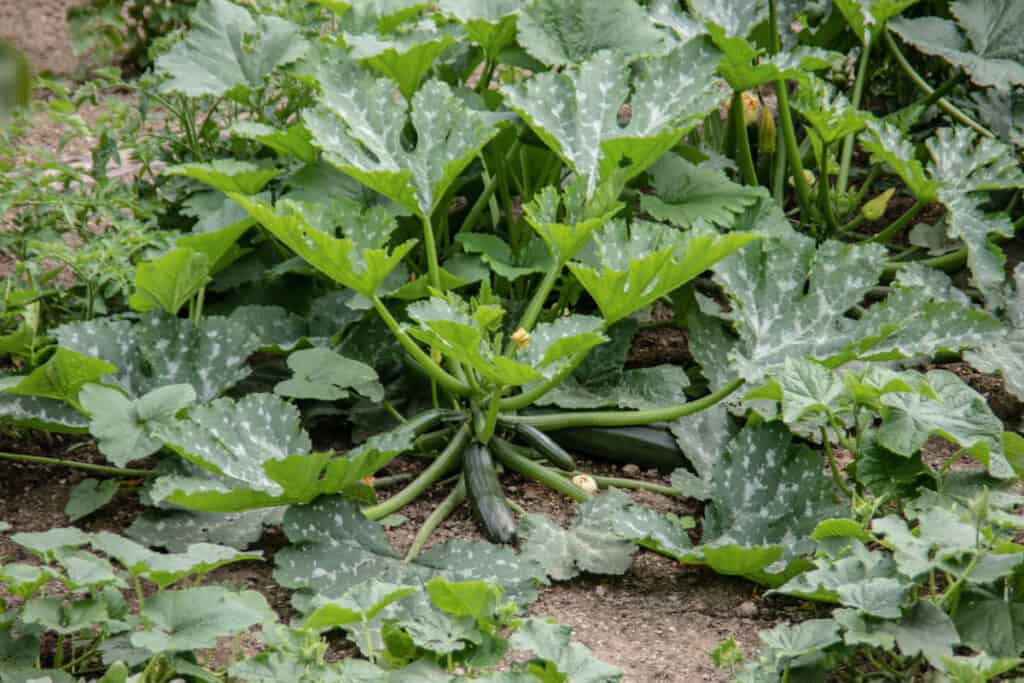
A fully mature zucchini plant. As you can see, one plant gets fairly large so plan accordingly!
Plant in an area with full sun in garden soil that is full of organic matter such as aged manure. They need at least one inch of water per week, more if it is really hot in your area.
Consider using drip irrigation to help prevent powdery mildew and to conserve water. Mulching is also a great idea to prevent water evaporation and weeds.
How long does it take for zucchini to grow?
Zucchini and all summer squash grow really quickly so are a great choice for your vegetable garden if you live in an area with a short growing season. It only takes about 45-55 days from the time you plant the seed, until you will start seeing flowers form on the plants.
The male flowers are on short stems and the female flowers are on longer stems. The zucchini blossoms are also edible, and most often stuffed or fried.
Once the plants begin forming fruit, you can harvest zucchini when they are about 6" or larger. Pick the fruit often, as leaving fruit to age on the plant slows down production so you will get a smaller harvest overall.
If you plant does not begin forming zucchini fruit, you may need to help pollinate the flowers.
Zucchini are one of the fastest growing vegetables. See my article 13 Fastest Growing Vegetables to read about other vegetables that grow quickly.
How to Pollinate Zucchini
Summer squash plants are not self pollinating and are usually pollinated by bees and bumblebees. You do not need more than one plant for successful pollination.
If you do not see any fruit maturing on your plant, you may need to intervene and help pollinate the female flowers.
Zucchini flowers tend to be more wide open early in the day and close by mid afternoon. Look for only wide open flowers to use for pollinating.
You will want to snip off a male flower early in the day and remove it's petals carefully. Then gently roll the pollen from the male flower onto the stigma of the female flower.
How many zucchini per plant
This depends greatly on how healthy your plant is, it's growing environment and how often you pick the fruit. But on average, one plant can produce 6-10 lbs of fruit or more.
How to grow zucchini in containers
If you have less space in your garden and do not want your summer squash plants to take up all the room, you can grow zucchini and summer squash in a container.
They will require a large pot, 5 gallons or more to have enough space and need a well-drained soil. Make sure there are adequate drainage holes.
In container gardening, you may need to water more often as container plantings dry out much faster than plants in the ground. You also may need to fertilize more often to ensure that there are enough nutrients and that they have not washed away with your watering.
See my article 15 Best Vegetables for Container Gardens for more info on container growing.
Do Zucchini Need a Trellis - Can Zucchini Climb a Trellis?
Before we can answer this question, we need to understand that there are different types of zucchini and summer squash varieties. Different varieties of plants often have different growing requirements.
Types of Zucchinis & Summer Squash
As with most types of vegetables, there are lots of different varieties of zucchini and summer squash. So be sure to read your seed packet, or Google the variety you are growing, to learn more about it and to determine if it is a vining variety or a bush variety.
Growing Bush Zucchini & Summer Squash Varieties
Most common zucchini and summer squash varieties are bush varieties, which mean they are not a vining plant. But there are climbing varieties available, although they are more rare.
These common bush varieties are rather large, and take up a lot of space. They may reach 3'-5' around when fully mature, so be sure to account for this amount of space when planning your garden bed layout.
Bush zucchini and summer squash varieties, do not need a trellis of any type to grow. They will also not "climb" a trellis.
However, providing them some vertical support and pruning some of the excess leaves off of the plant, can be advantageous.
By reducing the amount of leaves, and tying some of the larger leaves up higher to a support, provides better airflow to the plant, which can help prevent fungal diseases and powdery mildew.
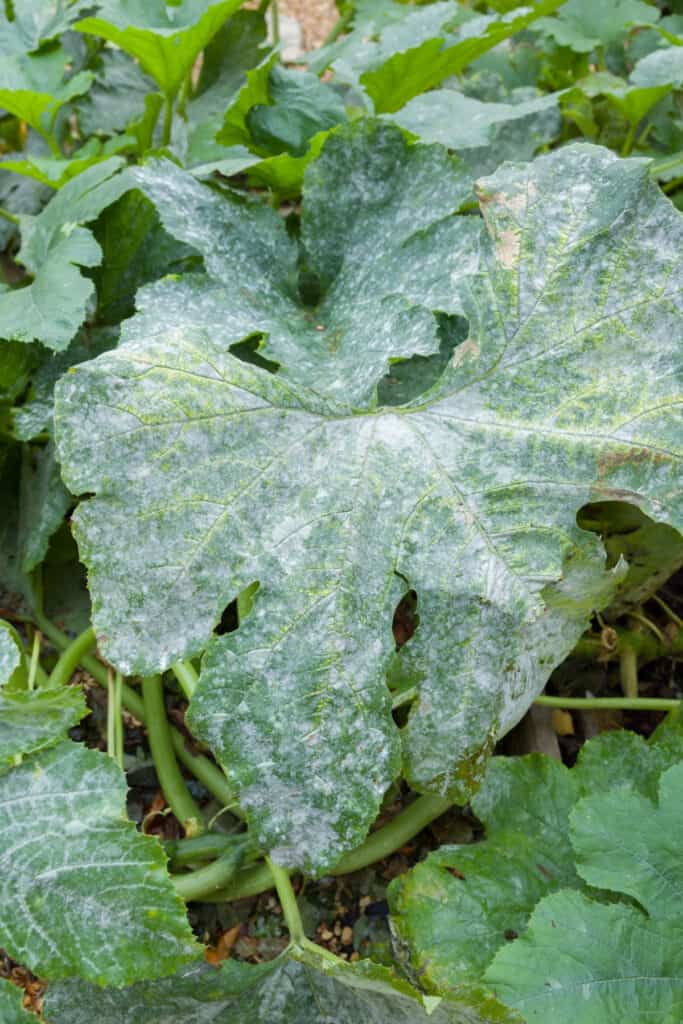
This is a close up of powdery mildew on a zucchini leaf.
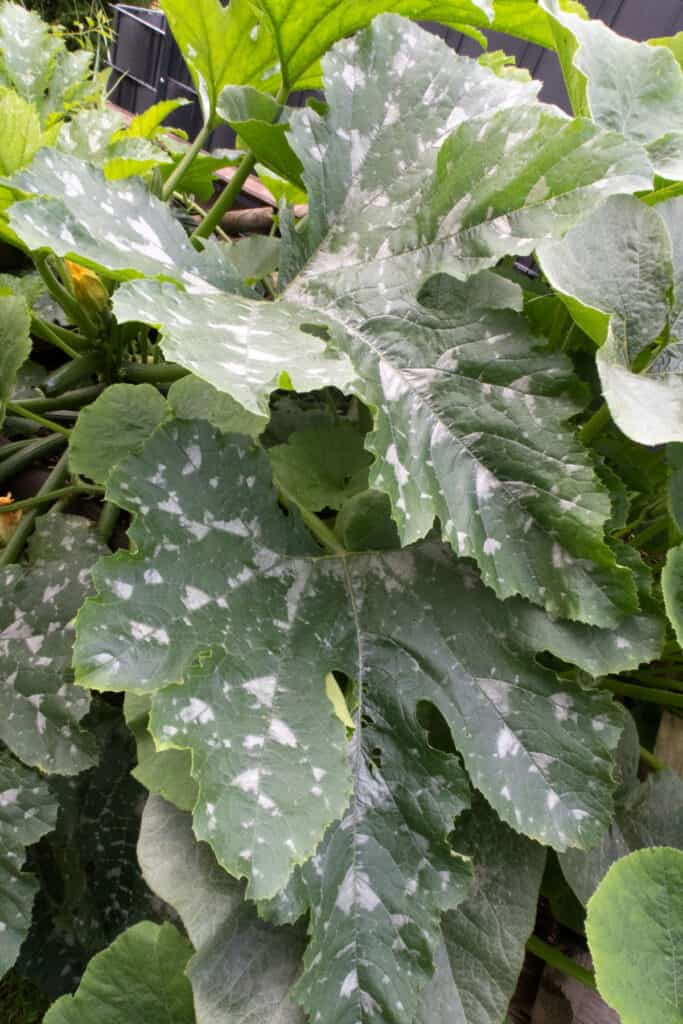
I wanted to share this photo also. Some varieties of zucchini and squash have a leaf pattern that is often confused as powdery mildew. The white splotches on here are NOT powdery mildew, just the pattern on this variety of squash.
So yes, you can use a smaller trellis to help provide better air flow to zucchini plants.
Common zucchini varieties include: Black Beauty, Grey, Golden, Cocozelle, Round and Green Machine.
Common summer squash varieties include: Straight Neck, Crook Neck, Patti Pan or Scallop.
Growing Climbing Zucchini & Summer Squash
Popular climbing and vining varieties of cucurbits are winter squash, pumpkins, loofah, gourds, bitter melons, cucumbers, watermelons, etc. People often grow these vine vegetables on trellises or supports of all kinds.
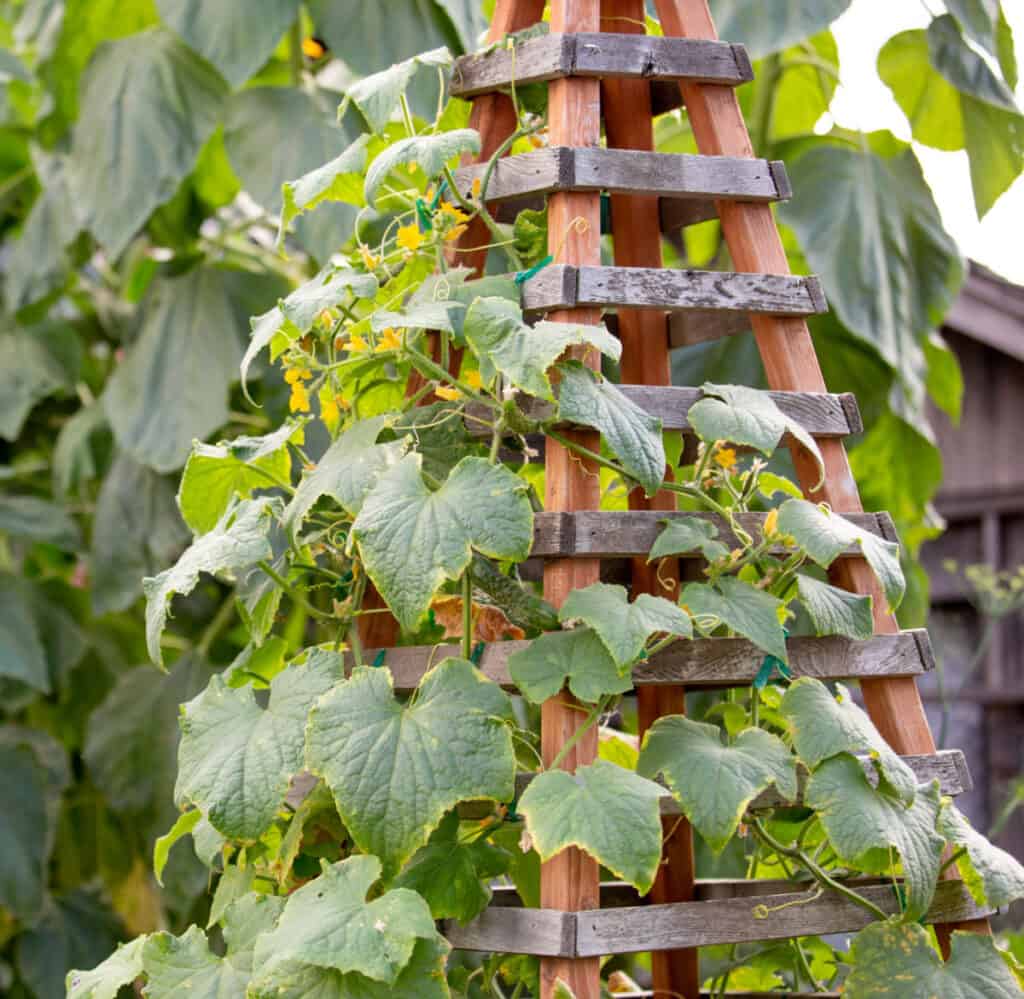
This is a cucumber plant growing on a wood support. Most cucurbit plants are veining and are often grown on trellises or other supports, but most often, zucchini is a bush plant, not requiring any vertical support.
Because of these plants in the same family as zucchini, many folks may assume incorrectly that zucchini plants are also a vining plant.
However, there are only a few climbing zucchini and summer squash varieties and these varieties will "climb" a trellis.
Climbing zucchini and summer squash varieties include: Thunderbird, Graybeard, Black Forest, Zucchino Rampicante, Zucchetta Rampicante, Trombocino, Italian Trombone Squash 'Tromba d'Albenga'. These seeds are much harder to find!
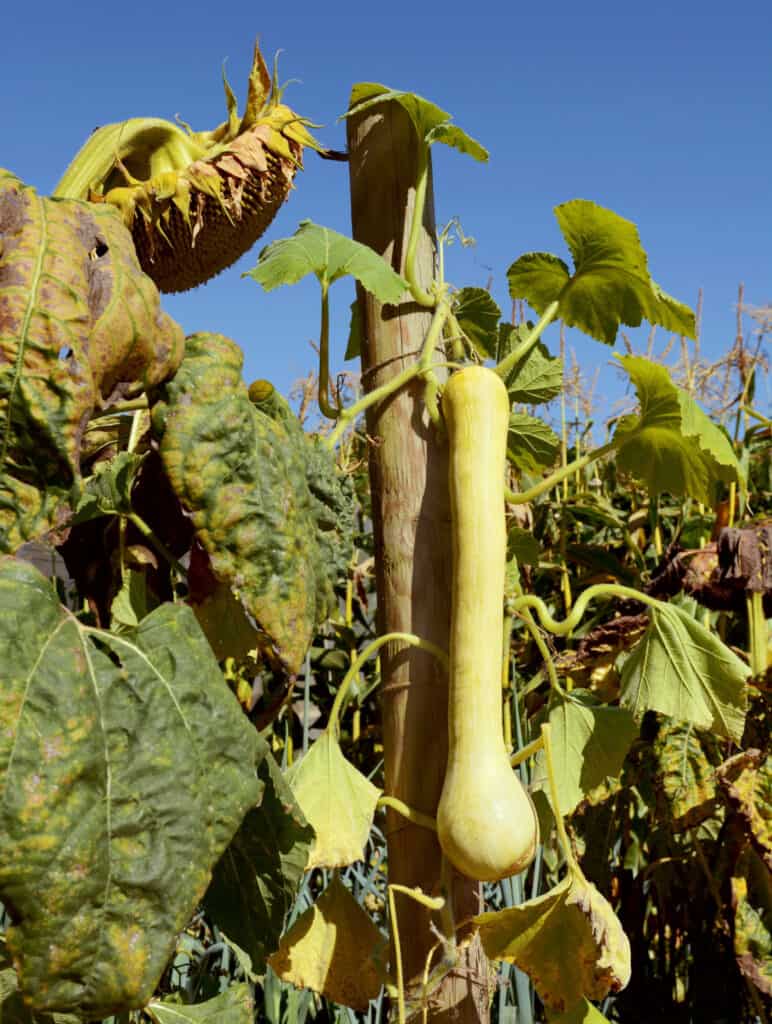
This is a zucchini rampicante growing on a vertical support and it is one of the few climbing varieties of zucchini.
A vining variety can definitely be grown on a trellis or vertical support system, and are ideal for growing in a small space. The tendrils you may see on these plants, are usually not strong enough to support the weight of the plant, so they will need to be tied to their support structure.
How to Grow Zucchini on a Trellis
You will want to plant your zucchini on the south side of a trellis support so that it gets the most sun. Center the main stem of the plant on the front of the trellis or vertical support.
You could also use rigid fencing or a tomato cage as a zucchini trellis. Just make sure that it is a strong trellis that is anchored in well to support the plant.
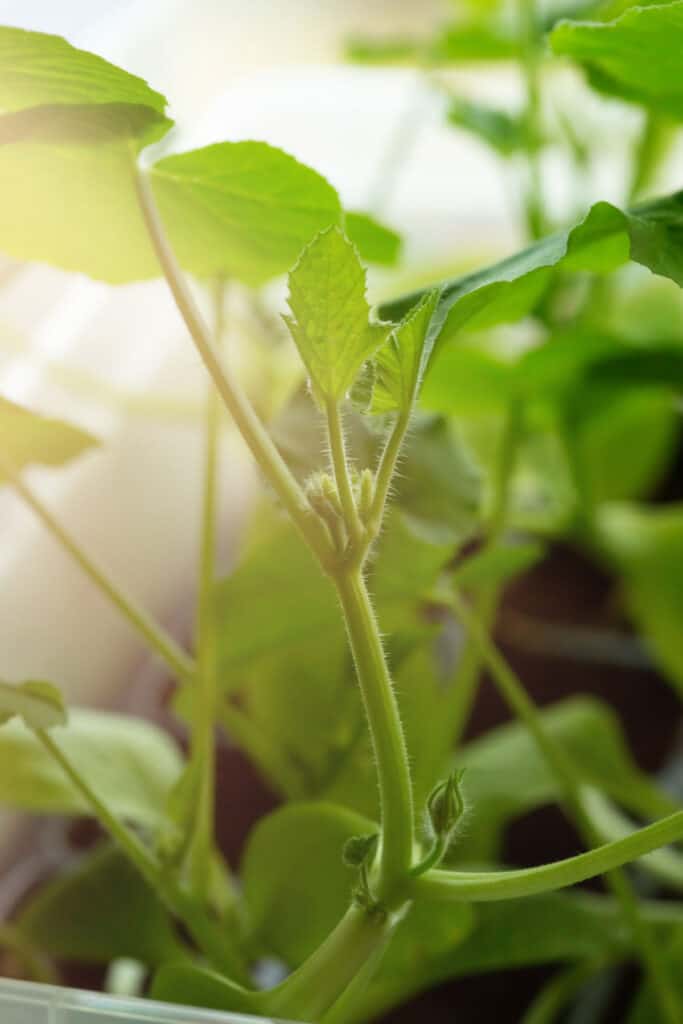
A vining cucurbit plant arm. A bush zucchini does not have climbing arms like this, but a climbing one will. You can weave this arm into a vertical support, but it is best to tie it on also because if this branch fruits, it will be too heavy for the plant arm to support itself.
If you are growing a bush variety, you will not get long stems growing as most vining plants have. Instead, you can trim the lowest leaves of the plant, and tie the upper leaves to the support.
This creates better air flow, and is better suited for very humid environments. You will not need a tall trellis for bush varieties, 3'-4' tall is probably suitable.
If you are growing a vining variety, these will send out longer stems that you can wrap or tie to the trellis. You may want a taller trellis system as well, possibly 6' or more.
You may still want to trim some of the lower leaves off of a vining plant to help with the airflow.
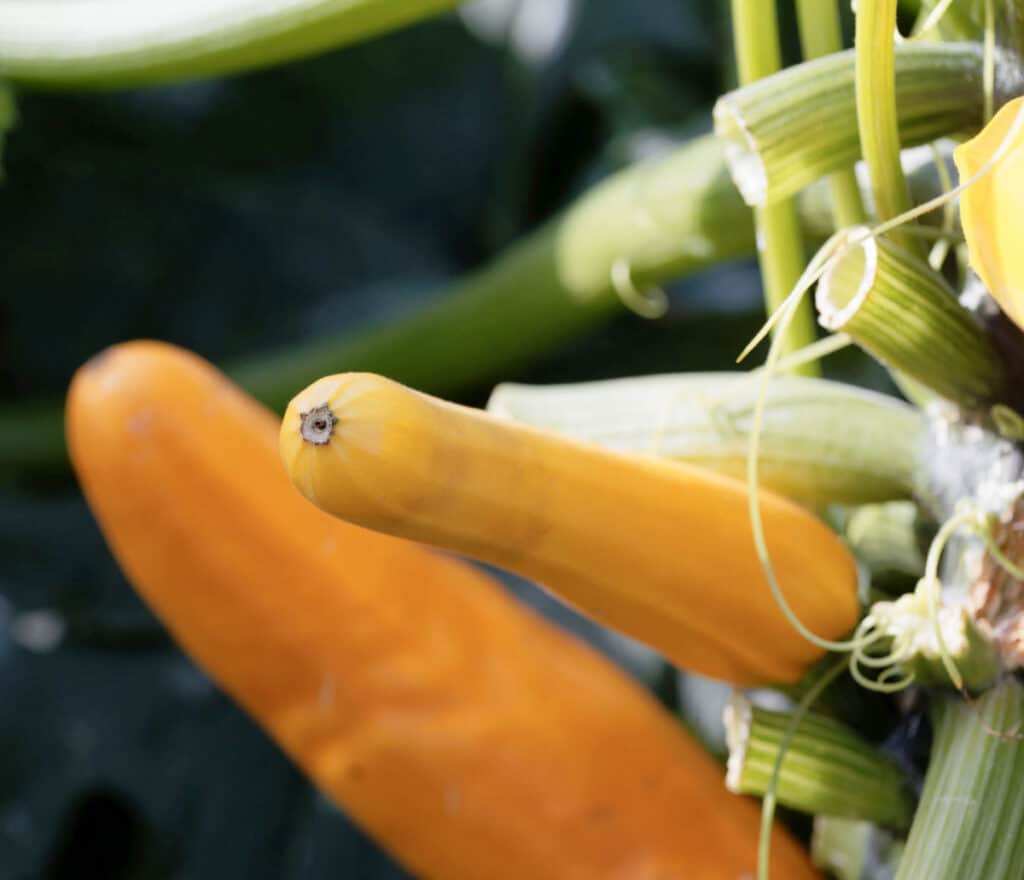
This is a close up of a zucchini plant that has had some of it's leaves pruned.
How to Prune Zucchini
I have mentioned a couple of times how you may want to remove some of the lower leaves of your zucchini plant. This is also called pruning the zucchini plant.
You basically want to remove any leaves that are laying on the ground, or laying on each other near the bottom of the plant. If you live in a dry climate, this is not as necessary as if you live in a wet or humid climate.
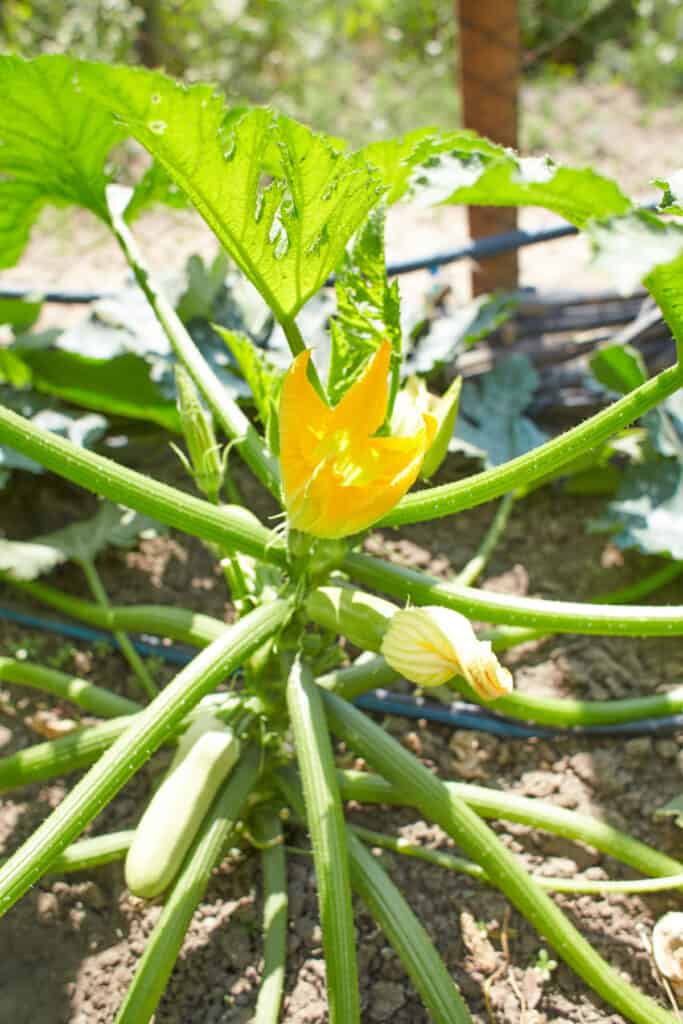
This zucchini plant is a good example of a plant that could use some pruning of the lower leaves.
Removing some of these leaves creates more room for good air circulation, which helps prevent powdery mildew and other fungal diseases. Not watering from overhead, and using a drip irrigation system or hand watering at the soil level, will also help prevent these issues.
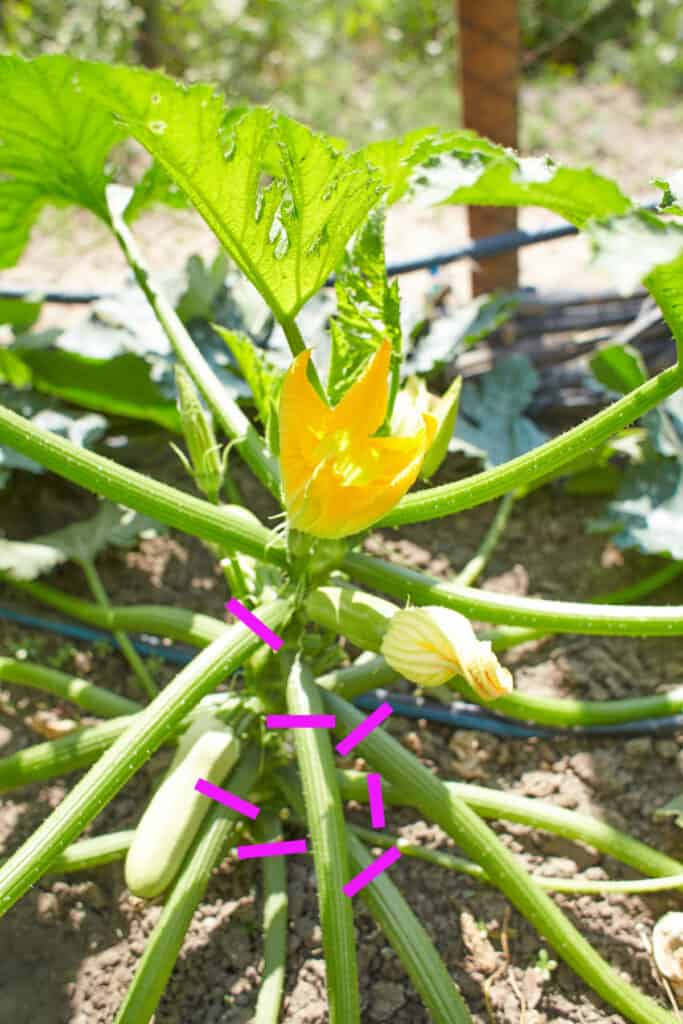
This is the same zucchini plant shown above, and I have placed magenta markings on the leaves that I would prune off, showing approximately where I would prune them. I only indicated the leaves that could be clearly seen in the photo, there are likely more leaves on the opposite side that I would trim likewise.
Dealing with Squash Bugs and other pests
If you live in an area where squash bugs aka squash vine borers, cucumber beetles or other pests are a problem, there are some things you can try to combat them.
If you have a long growing season, consider growing an early crop or a late crop of summer squash, and you may find you are able to harvest fruit before or after the period when these pests are most active in the heat of summer.
You can also try using insect row covers to keep the pests away from the plants. If you are only growing one plant, neem oil is another option, but would not make sense to use if you are growing a large amount of summer squash or other cucurbits.
Final thoughts
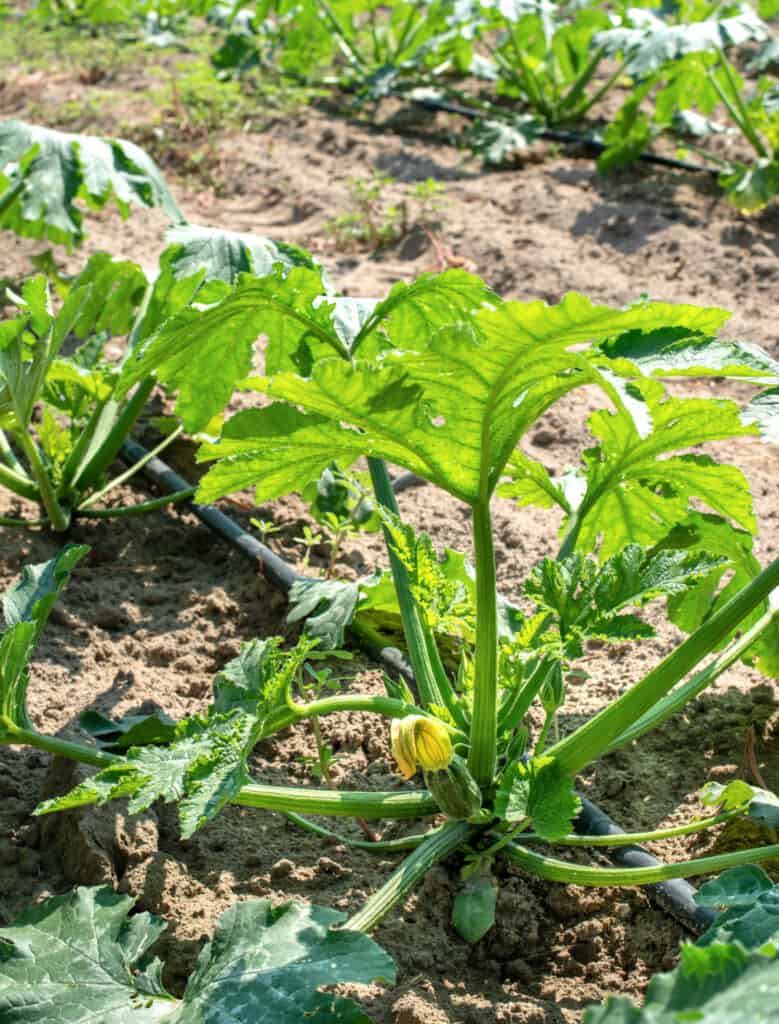
This is a good example of a zucchini plant that probably does not need to be pruned as it has good space around it for air circulation.
I hope you have learned some things about growing summer squash and zucchini and when a trellis might be best used when growing them. Good luck growing , and I hope you get some bountiful harvests with your summer crop!
Please let me know if you have any more questions on growing zucchini or summer squash.
Other Articles You May Be Interested In:
Food Security via Vegetable Gardening
Why Are My Cucumber Leaves Turning Yellow?
Want to Remember This?
I truly appreciate any shares of this article on social media such as Facebook or Pinterest! Thank you!
Please save "Does Zucchini Need a Trellis + Other Growing Tips"
to your favorite Gardening Pinterest Board!



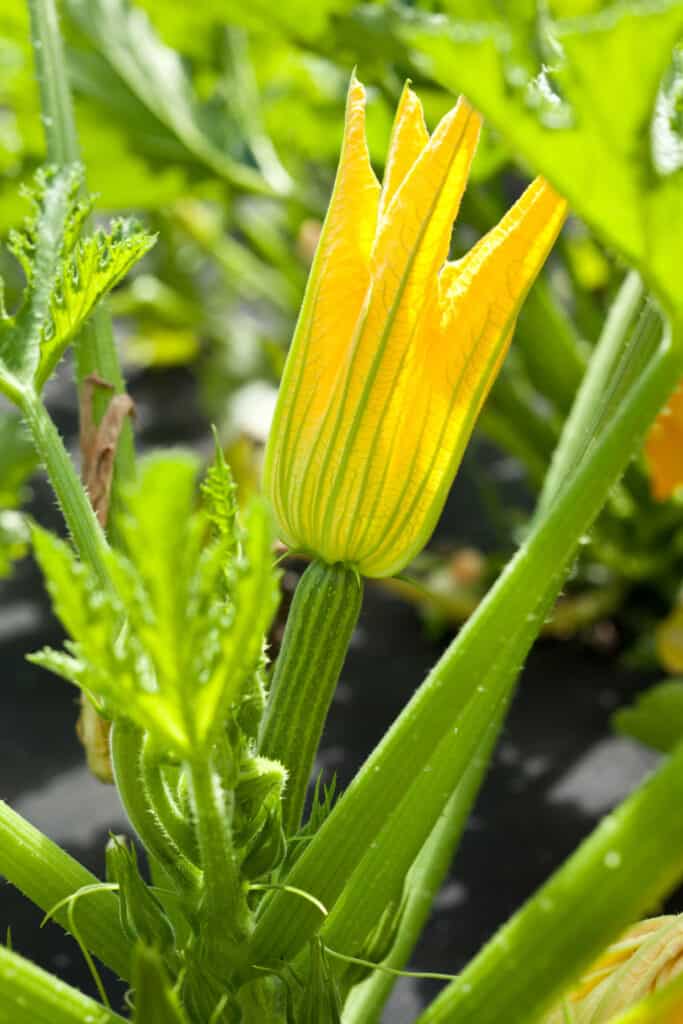
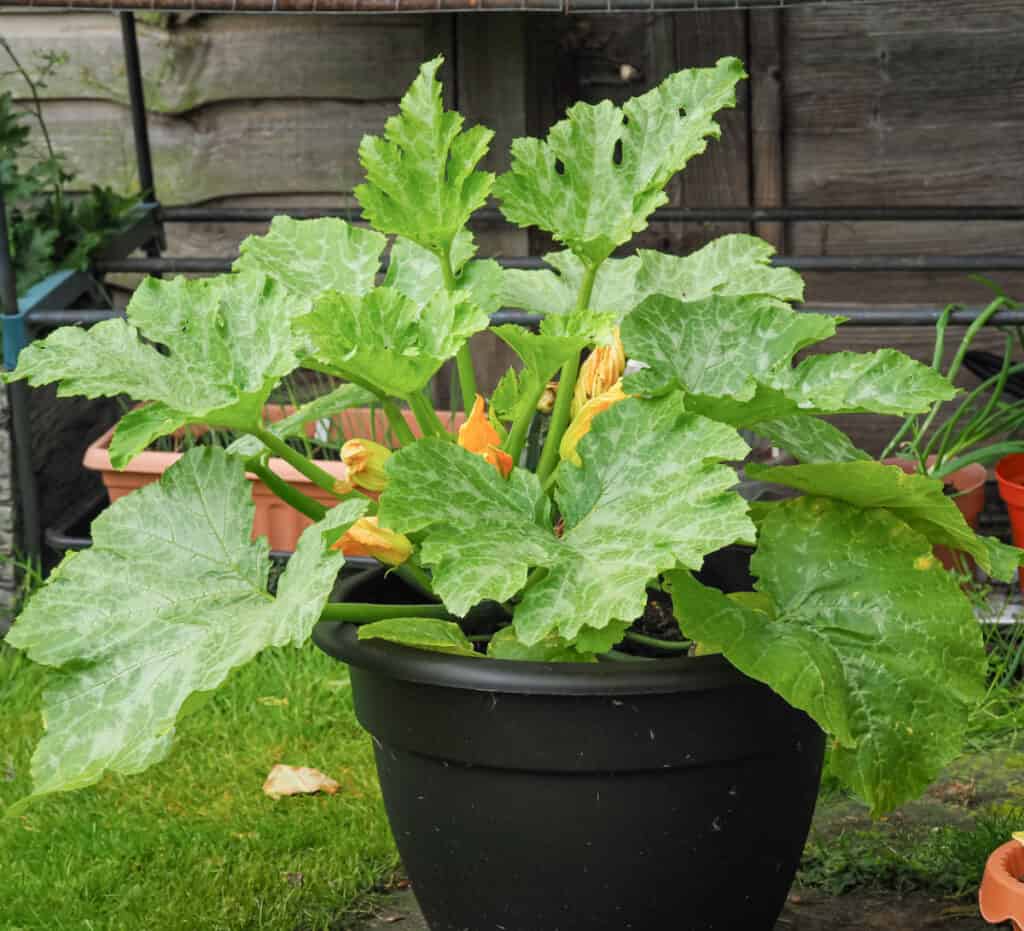
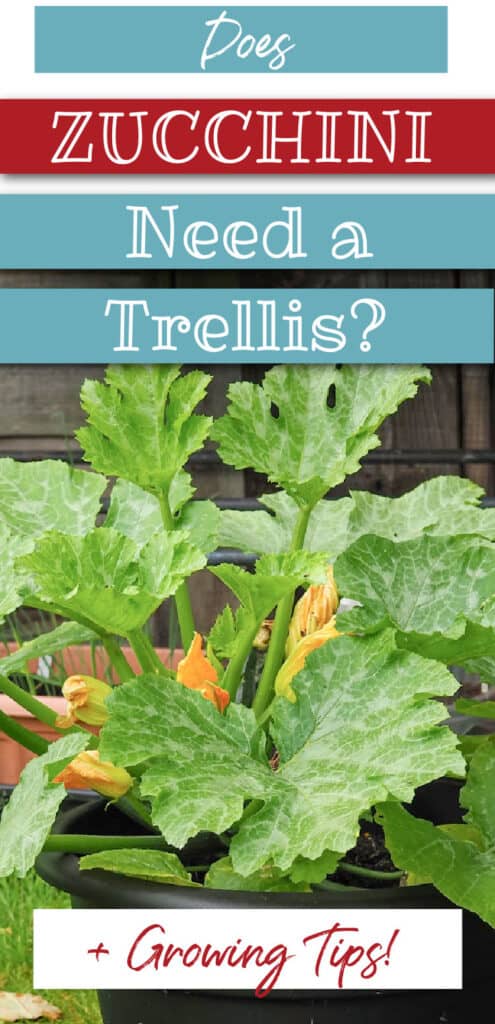
Leave a Reply